Carex oshimensis ‘Evergold’
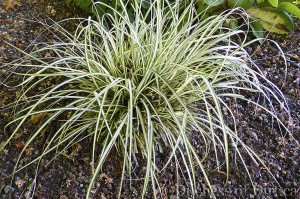 Carex oshimensis ‘Evergold’
Carex oshimensis ‘Evergold’
(KAIR-ecks oh-shih-MEN-siss)
syn. Carex morrowii ‘Aureovariegata’
Family: Cyperaceae
Common name: variegated Japanese sedge
Zone: 5 – 9
Height: 10 – 16 in (25 – 40 cm)
Spread: 10 – 16 in (25 – 45 cm)
Aspect: partial shade; full shade
Soil: medium; moist; well-draining
Water: moderate; regular
Description: A slow growing, evergreen perennial grass with a dense, clump-forming habit. Narrow leaves with creamy yellow centres edged in green form a ground-hugging, arching fountain shape. Insignificant brown flower spikes on triangular stems appear in summer.
Special Notes: Native to the rocky slopes and dry wooded areas of Honshu Island, Japan where it is commonly known as Oshima kan suge. A low maintenance, fine-textured grass which tolerates moist areas such as beside ponds but needs good drainage. Most references place this in at least partial shade but it does well in full sun with regular water. Foliage can be cut back to a low mound in late winter to rejuvenate the leaves. Spreads by rhizomes. Propagate by division in early spring or autumn. Relatively few pests and disease problems. Deer and rabbit resistant.
In our Zone 7a garden: Several clumps of ‘Evergold’ dot the landscape in my front garden as this grass species does exceptionally well in competition with the roots of my chestnut tree (Aesculus hippocastanum) and silverleaf maple (Acer saacharinum). As for deer resistance, I cannot confirm this fact as our garden is completely fenced against buffet-hunting ungulates. However, there are rabbits in the neighbourhood which can sneak in but they completely shun this grass, preferring to nibble on another grass called, Hakonechloa macra ‘All Gold’, my tulips and hosta leaf tips instead.
RHS Award of Garden Merit 1993
Posted on April 27, 2013; updated on October 30, 2024
Carex ‘Silver Sceptre’
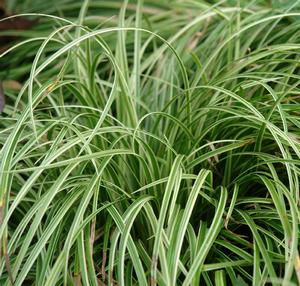 Carex ‘Silver Sceptre’ Family: Cyperaceae
Carex ‘Silver Sceptre’ Family: Cyperaceae
(KARE-eks mor-OH-ee-eye)
Common name: Japanese sedge
Zone: 5 – 9
Height: 8 – 12 in (20 – 30 cm)
Spread: 12 – 24 in (30 – 60 cm)
Aspect: full sun; partial to full shade
Soil: average; well-draining
Water: moderate
Description: A short, evergreen, perennial grass with a clump-forming, slow-spreading rhizamous habit. White margins brighten the narrow (0.25 inch / 6.4 mm) green leaves. Insignificant greenish-brown flowers on triangular stems appear in mid-spring.
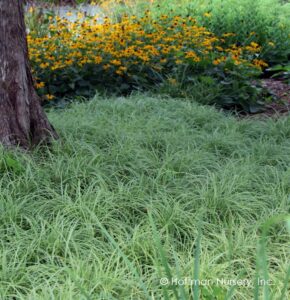 Special Notes: This grass has a preference for partial to full shade, although it will tolerate full sun if watered regularly. Given shade, it is drought tolerant once established. Evergreen in the warmer regions of its range but semi-evergreen in the cooler regions, and may go dormant in Zone 5 and lower.
Special Notes: This grass has a preference for partial to full shade, although it will tolerate full sun if watered regularly. Given shade, it is drought tolerant once established. Evergreen in the warmer regions of its range but semi-evergreen in the cooler regions, and may go dormant in Zone 5 and lower.
In spring, cut back to 2 or 3 inches (5-7.6 cm) before fresh new growth appears. Spreads slowly to form dense, arching clumps. Drought tolerant. Deer resistant.
This cool season grass cultivar was presented by Dr. Masato Yokoi, Japanese variegated plant specialist, to the English grass collector, Roger Grounds. Plants Delight Nursery of North Carolina introduced ‘Silver Sceptre’ to North America in 1999. It is often labeled as Carex morrowii ‘Silver Sceptre’ but its connection to this particular species of Carex has not been confirmed.
In our Zone 7a garden: ‘Silver Sceptre’ is evergreen in our garden and looks lovely in the shady side of my front border under the towering chestnut (Aesculus hippocastanum) and silver leaf maple (Acer saacharinum) trees, providing bright spots of tumbling variegated strap-like leafy clumps.
Posted on August 17, 2012; updated on October 16, 2024
Carex elata ‘Aurea’
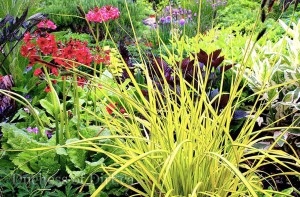 Carex elata ‘Aurea’
Carex elata ‘Aurea’
(KARE-eks ee-LAY-tah)
syn. Carex stricta ‘Aurea’
Family: Cyperaceae
Common name: Bowles’ golden sedge
Zone: 5 – 9
Height: 18 – 24 in (45 – 60cm)
Spread: 24 – 36 in (60 – 90cm)
Aspect: full sun; partial to full shade
Soil: fertile; moist
Water: regular
Description: A slow growing, evergreen perennial grass with a tuft-forming habit. Narrow, bright yellow leaves with a thin edging of dark green form a pleasing arching fountain shape. Less sun results in a more lime green leaf colour. Small black flower spikes appear on erect stems in early summer.
 Special Notes: This cultivar was discovered by E. A. Bowles growing wild in a garden in Norfolk, England. A low maintenance grass which also grows well in containers. Preference is for moister areas such as beside ponds or in boggy areas. Relatively few pests and disease problems. Deer resistant. Will self seed but sporadically. In late winter of early spring, cut leaf blades back to 8 to 12 inches (20 to 30 cm) in height, preferably just as new green growth starts to appear. DO NOT cut tips of new growth at the risk of stopping their growth. Propagate by division in early spring or autumn.
Special Notes: This cultivar was discovered by E. A. Bowles growing wild in a garden in Norfolk, England. A low maintenance grass which also grows well in containers. Preference is for moister areas such as beside ponds or in boggy areas. Relatively few pests and disease problems. Deer resistant. Will self seed but sporadically. In late winter of early spring, cut leaf blades back to 8 to 12 inches (20 to 30 cm) in height, preferably just as new green growth starts to appear. DO NOT cut tips of new growth at the risk of stopping their growth. Propagate by division in early spring or autumn.
RHS Award of Garden Merit 1993; Great Plant Pick 2002
Posted on March 12, 2013; updated on October 9, 2024
Cardamine hirsuta – hairy bittercress
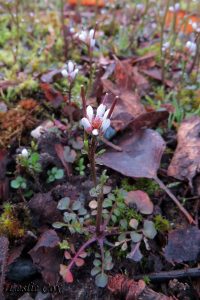 Cardamine hirsuta Family: Brassicaceae
Cardamine hirsuta Family: Brassicaceae
(kahr-DAM-uh-nee hur-SUE-tah)
Common name: hairy bittercress, snapweed
Type: weed; self-seeding annual
Zone: 4 – 8
Height: > 12 in (30 cm)
Spread: 6 in (15 cm)
Aspect: full sun; part shade
Soil: moderate
Water: moderate
Description: An herbaceous self-seeding annual with an erect habit. Dark green leaves form a basal rosette at the base of the stem, or stems. They are pinnately divided into 8-15 round or ovate leaflets, attached at the petiole by short stems. Leaflet edges are gently scalloped, looking like clubs on a deck of cards. There are also leaves growing up the stem, called cauline leaves. They too are pinnately divided, but have fewer leaflets and are usually smaller than the basal leaves. The upper surface of the cauline leaves, the petioles, and the stems are sparsely covered in minute hairs.
 Special Notes: Initially native to Eurasia, hairy bittercress has made it into many countries across the globe…thanks to the global movement of plants. Of particular note, the flowers are “complete”…having both female and male sexual parts. Each flower is also capable of self-pollination. No need to wait for wayward pollinators. Cardamine hirsuta is a prolific seeder with about 20 seeds in each pod and several pods on each plant. Each pod contains a release mechanism which can hurl the seeds up to 3 ft (1 m) away.
Special Notes: Initially native to Eurasia, hairy bittercress has made it into many countries across the globe…thanks to the global movement of plants. Of particular note, the flowers are “complete”…having both female and male sexual parts. Each flower is also capable of self-pollination. No need to wait for wayward pollinators. Cardamine hirsuta is a prolific seeder with about 20 seeds in each pod and several pods on each plant. Each pod contains a release mechanism which can hurl the seeds up to 3 ft (1 m) away.
Its life cycle is quite short for a plant. New seedlings start to appear as soon as temperatures start to warm up in late winter/early spring and there are several generations produced until the plants die as temperatures dip towards winter. The seeds, however, are frost hardy and hibernate through the worst of the winter season…just waiting for spring. Because of this specie’s multi-generations and proficiency in producing good numbers of seeds…some claim as many as 600 in a season from just one plant’s progeny…it is highly recommended the gardener stay on top of the weeding.
In our Zone 7a garden: We have this weed in our garden…thanks to our penchant for combing numerous nurseries and acquiring many wonderful plants over the years. Thankfully, we both love to weed as it is a really good way of being one with the garden. And the experts are not kidding! You must stay on top of this prolific weed!
Posted on January 20, 2017; updated on October 14, 2024
Campanula lactiflora ‘Loddon Anna’
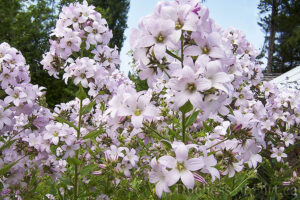 Campanula lactiflora ‘Loddon Anna’
Campanula lactiflora ‘Loddon Anna’
(kam-PAN-yew-lah lak-tih-FLOOR-ah)
Family: Campanulaceae
Common name: milky bellflower
Zone: 4 – 8
Height: 6 ft (1.8 m)
Spread: 3 ft (0.9 m)
Aspect: full sun; partial shade
Soil: fertile; well-draining
Water: moderate
Description: An herbaceous perennial with an upright habit. Medium green, oblong, toothed leaves on strong stems. Panicles of soft lavender-pink, delightfully fragrant, bell-shaped flowers appear in mid-June through July and August.
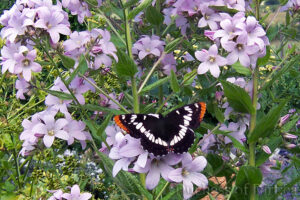 Special Notes: Native to the Caucasus region and eastern Turkey. Has commanding presence in the garden. Requires staking in its second year in exposed location. Long bloom period that attracts bees and butterflies. May produce a second flowering if cut back when first flush is ending. May suffer some slug and snail damage early in season. Propagation by seed; division in spring or autumn.
Special Notes: Native to the Caucasus region and eastern Turkey. Has commanding presence in the garden. Requires staking in its second year in exposed location. Long bloom period that attracts bees and butterflies. May produce a second flowering if cut back when first flush is ending. May suffer some slug and snail damage early in season. Propagation by seed; division in spring or autumn.
RHS Award of Garden Merit 1993; Great Plant Pick 2008
Posted on August 17, 2012; updated on October 2, 2024
